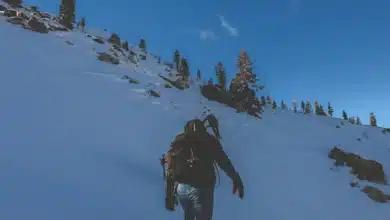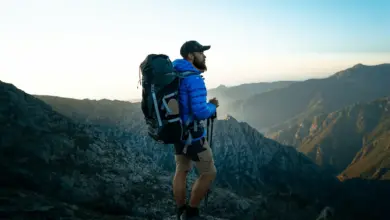14 Tips For Safe Hiking This Winter
14 Tips For Safe Hiking This Winter
Winter is an extra dangerous time for hiking. You must take extra caution from the very beginning of the planning stages to gear selection, to bringing the right gear, and being extra careful when out on the trail. Please keep in mind the following winter hiking safety tips.
#1. Plan for a safe trip
Not everyone enjoys planning, but it can be fun and is an important part of the hike. Trip planning will become easier with practice. Routes will become more familiar and you will gain experience as you do more hikes.
#2. Start small and don’t overestimate your ability
If you are new to hiking, or out of shape, try picking a trail that is easier. As the season progresses, you will gain experience and fitness to do more challenging trails. It’s important to be conservative with how long a trial will take. Unlike the summer, hiking a couple extra miles in the dark can be a lot more dangerous.
#3. Do your research
Always check the weather before heading out. Checking the weather isn’t only for trail and mountain conditions, but also for driving conditions to the trailhead. If the weather shows high winds, colder temperatures, or avalanche warnings, you may want to reconsider your date and/or trail. If there is fresh snow, consider bringing snow chains for your vehicle. Check out the NOAA website for weather, warnings, and forecasts.
Understanding the trail beforehand will help you estimate hiking times, along with any dangerous areas. It will also help prevent you from getting lost. Trail markers may be covered in snow, making it harder to navigate.
#4. Make a safe plan for the whole group
Never go hiking alone. It’s so easy to get disoriented, miss a turn or marker, read the map wrong, get injured, or miss a piece of gear you thought was packed.
When making a plan, consider your group. Is there anyone in the group that gets cold easily? Or has knee issues? Take this into account when picking a route.
Make sure everyone at your party knows where you are going and what to expect.
Before you leave for your trip, write down the names of all the members in the group, vehicle information, where you are going, which trail you intend to take, and when you think you will be back. In the event you don’t return in a reasonable manner, this will provide valuable information for search and rescue.
You may also like Do You Need to Worry About Bears in Winter?
#5. Have proper gear
It’s helpful to test your gear before you actually hit the trail. Going for a walk around your neighborhood and playing in the snow will give you a sense of how warm you need to dress and if any gear will get wet.
#6. Dress in layers
Dressing in the proper layering system will help you stay warm and dry. An outer shell could very well save your life. Bringing extra layers will help you stay warm, especially when you stop for rest or if one layer gets wet.
#7. Wear proper traction
Unless you are going on a short nature walk in packed snow, having the right traction from snowshoes or crampons will prevent slips and falls and keep you upright. Remember not to become over-ambitious just because you have proper gear.
#8. Bring a headlamp
It gets darker much quicker in the winter. Be sure to take this into account when planning and take a headlamp with extra batteries. Lithium batteries perform great in cold weather.
You may also like Do Hiking Boots Work in Snow?
#9. Carry a map and compass, and know how to use them
A GPS can be helpful, but should never be relied upon. Learn to use a map and compass, and frequently check the map with at least one other person. Maps can be easily made weatherproof by covering them in clear packaging tape. Carrying two compasses will ensure that they are working properly. Learning to navigate by the Sun and stars is also helpful.
#10. Bring emergency supplies
Below are some emergency supplies that can be carried in your pack.
- Be prepared to spend the night. This means bringing an emergency shelter, busy, or sleeping bag.
- Hand and toe warmers will help prevent frostbite.
- A multi-tool can help repair gear and start fires.
- A first aid kit will patch any cuts or scrapes.
- If you get lost or injured, three rings from a whistle can alert search and rescue.
- Space blankets are cheap, lightweight, and take up little space.
- A cell phone can alert emergency services and check the weather.
#11. Hike safe
When winter hiking, it’s extra important to stay aware of your surroundings. Trails, markers, and turns may be harder spots when they are covered. Always be on alert for ice and pay attention to your body.
#12. Stay fueled and hydrated
Staying hydrated can be more challenging in the winter. The air is dryer and drinking cold water is not always appealing. Consider bringing a small portable stove for coffee or hot chocolate eating foods that are high in calories will help you stay warm and energized. be sure to eat and drink frequently.
You may also like Are Winter Boots Waterproof? It Depends
#13. Pace yourself and rest when needed
Pacing yourself will help prevent you from sweating and overheating. It will also give you a chance to look at the map and refuel. it’s also a good time to check the weather and make sure everyone in your party is comfortable.
#14. Know when to turn around
It’s easy to be emotionally invested in a hike, especially after all the planning and hiking. Don’t make a risky decision simply because you are emotionally invested in the hike. If the weather is bad, turn around And try again another day. That mountain will always be waiting for you.



